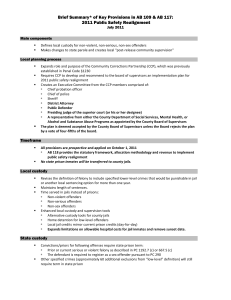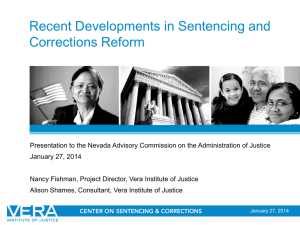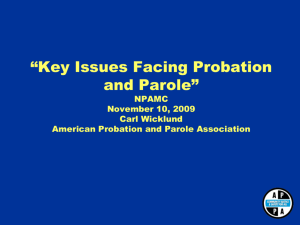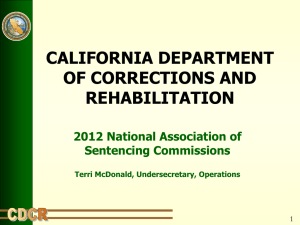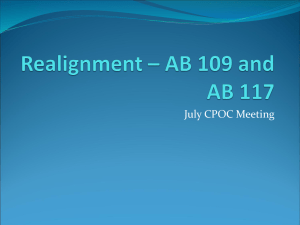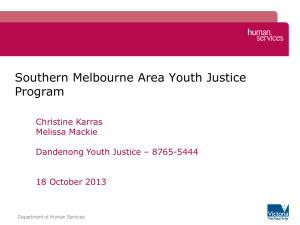PowerPoint Overview - California Police Chiefs Association
advertisement
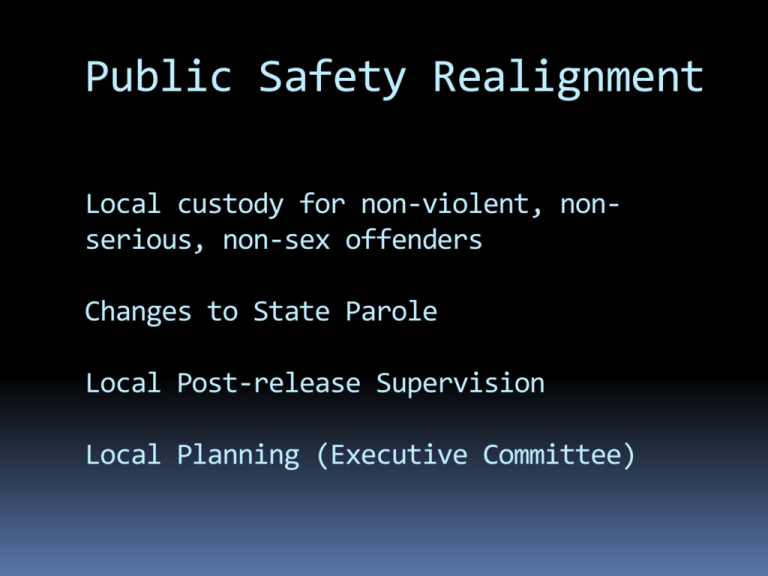
Public Safety Realignment Local custody for non-violent, nonserious, non-sex offenders Changes to State Parole Local Post-release Supervision Local Planning (Executive Committee) Community Corrections Partnership Shall recommend local plan to the county board of supervisors for the implementation of the 2011 public safety realignment. Executive committee: Chief Probation Officer (Chair), A Chief of Police, Sheriff, District Attorney, Public Defender, Presiding Judge of the Superior Court, and an additional county health and human service representative appointed by the Board of Supervisors When Does it Begin Prospectively applied after October 1, 2011 or upon funding. AB 118 provides the statutory framework, allocation methodology and revenue to implement the 2011 public safety realignment. •Community Corrections Partnership The CCP plan is deemed accepted by the County Board of Supervisors unless the Board rejects the plan by a vote of four-fifths of the Board. Who is sentenced to local custody? Revises the definition of felony to include certain crimes that are punishable in jail for more than one year. Maintains length of sentences. Time served in jails instead of prisons: Non-violent offenders Non-serious offenders Non-sex offenders Additional Features of Realignment Enhanced local custody and supervision tools: Alternative custody tools for county jails Home detention for low-level offenders Local jail credits like current prison credits (Day-for-day). Prospective from October 1, 2011. Who is Sentenced to State Prison? The following sentences must be served in state prison: Prior or current serious or violent felony as described in PC 1192.7 (c) or 667.5 (c) The defendant is required to register as a sex offender pursuant to PC 290 Excludes certain other specified crimes Note: “excluded crimes” are those for which a defendant can still be committed to state prison. Sentences that must be served in State Prison Examples of non-serious, nonviolent, non-sex offenses that would be required to serve time in prison: felony physical abuse of an elder or dependent, assault on a peace officer, possession of horse meat and bribing a legislator. Contracting Back Realignment allows counties to contract back with the State to send local offenders to state prison. Counties are authorized to contract with public community correctional facilities (CCFs). Contracting back does not include parole revocations. Prospectively from October 1, 2011 No state prison inmates will be transferred to county jails. X Post-release Supervision Board of Supervisors designate a county agency to be responsible for Post-release Supervision and inform CDCR by August 1, 2011. All 58 counties have identified Probation as the designated agency responsible for Post-release community supervision. Post-release Community Supervision CDCR must notify counties who is being released on post-release supervision at least 30 days prior to release. Post-release Supervision County-level supervision upon release from prison Current Non-violent offenders Current Non-serious offenders Sex offenders Does NOT include: 3rd strike Individuals with a Serious Commitment Offense Individuals with a Violent Commitment Offense High risk sex offenders as defined by CDCR Determining PRCS or Parole Supervision If an offender is released from prison on October 1st and completes the revocation on or after November 1st the parolee will either remain on parole or if the parolee qualifies will be placed on PRCS. Any parolee who is in a county jail serving a term of parole revocation on October 1st and is released directly from county jail without returning to a state prison on or after October 1st, that offender shall remain on parole. Post-release Supervision (continued) Allows revocations up to 180 days . Graduated sanctions including flash incarceration at the local level (revocations lasting longer than 10 days require a court hearing). Individuals on post-release supervision without any violations after six months can be discharged. Courts may adjudicate violations and new conditions of release at the local level. Post-release Supervision (continued) Specifies CDCR shall have no jurisdiction over any person who is under post-release community supervision and no person shall be returned to prison except for persons previously sentenced to a term of life (and only after a BPH order). State Parole Supervision Commitment offense: Current serious or violent felony as described in PC 1192.7 (c) or 667.5(c) The offender has been convicted of a third strike The person is classified as a mentally Disordered Offender (MDO) Or the person is classified as a high risk sex offender. State Parole Supervision Parole revocations will be served in county jail – not in state prison - for no more than 180 days. Contracting back from the state for revocations is not an option. Graduated sanctions including flash incarceration at the local level (revocations lasting longer than 10 days require a BPH hearing). Only persons previously sentenced to a term of life can be revoked to prison. State Parole Supervision Parole revocation process remains with Board of Parole Hearings (BPH) until July 1, 2013. The revocation process will transition to the Courts after July 1, 2013. State Parole Supervision For the remaining low level offenders on parole after implementation of realignment, parole has the authority to discharge after six months if no violations have occurred. The six month discharge is prospective and only applies if he or she has either: been on parole continuously for six months after October 1st and the person is not retained by BPH for good cause or the person has, on or October 1st been on parole for one year and the BPH does not retain for good cause. Juvenile Justice AB 109 proposed limits future juvenile court commitments to DJJ. AB 117 eliminates this provision and maintains the state’s process for committing youth to state facilities. New Changes to Realignment Allows Courts to propose split sentence to mandate probation as part of county low level offenders sentence. Expands limitations on allowable hospital costs for jail inmates and removes sunset date Elimination of Correctional Standards Authority and the new Board of State and Community Corrections (SB 92). Authorizing the conversion of a female prison to a male prison if necessary
